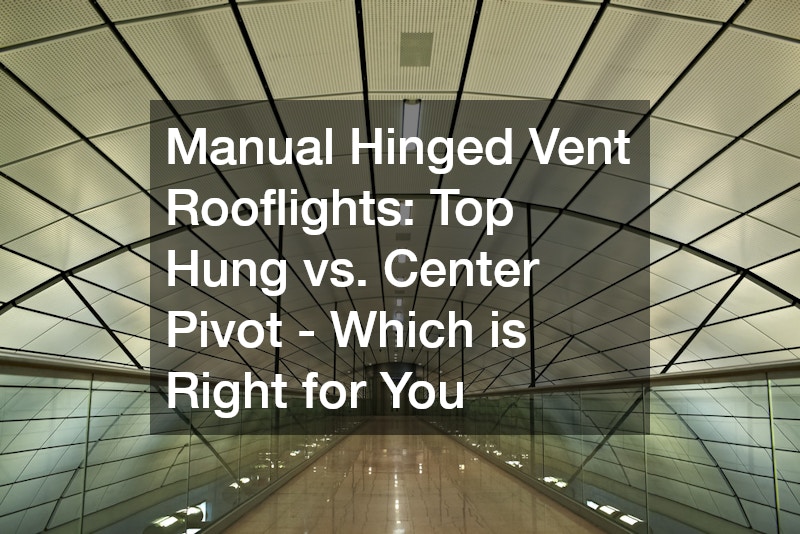When it comes to choosing rooflights for your home, understanding the differences between various opening mechanisms can be crucial in making the right decision. Among the popular options are Manual Hinged Vent Rooflights, which come in two main styles: top hung and center pivot. Each has its own advantages and considerations, so let’s delve into these two types to help you determine which might be the best fit for your needs.
Understanding Manual Hinged Vent Rooflights Manual Hinged Vent Rooflights are designed to provide natural light and ventilation by opening up to allow fresh air into your home. They are typically used in spaces where daylight and air circulation are essential, such as kitchens, bathrooms, or loft conversions. The manual operation involves a simple mechanism where you can open the rooflight by hand, offering a more controlled way to manage ventilation compared to electric options.
Top Hung Rooflights Design and Functionality
Top hung rooflights are hinged at the top, allowing the window to open outward from the bottom. This design creates an unobstructed view, as the window does not intrude into the room when opened. This can be particularly beneficial in spaces where you want to maintain a clear sightline or where there is limited room for protruding windows. The top hung mechanism also means that the window remains neatly tucked against the roofline, avoiding potential obstructions within the interior space.
Advantages
Uninterrupted Views: Since the window opens outward, it does not obstruct the interior, providing a clear view from inside. Space Efficiency: Ideal for rooms with low ceilings or furniture placement that could otherwise obstruct a pivoting window. Versatile Ventilation: Top hung rooflights can be equipped with a variety of blinds, including blackout and Venetian options, to control light and privacy. Considerations
Installation: The top hung design requires precise installation to ensure proper operation, especially in terms of hinge adjustments. Maintenance: While maintenance is generally straightforward, keeping the hinges and seals in good condition is important to prevent leaks. Center Pivot Rooflights Design and Functionality
Center pivot rooflights are hinged in the middle, allowing the window to pivot open like a door. This design creates a swinging motion that opens the window both inward and outward. It provides easy access for cleaning and maintenance, as the window can be opened fully to reach both sides. The center pivot mechanism is often favored for its convenience and ability to provide excellent ventilation.
Advantages
Ease of Cleaning: The full swing capability allows you to clean both sides of the glass without the need for external ladders or equipment. Enhanced Ventilation: The ability to open the window wide can improve air circulation and help in rapidly venting out stale air. Flexible Operation: Center pivot rooflights offer a straightforward mechanism that is easy to operate manually. Considerations
Interior Space: When opened, the center pivot rooflight may protrude into the room, which could be a concern if space is limited or if there are obstacles like furniture. Potential Obstruction: The swinging window can occasionally obstruct the view or interfere with the room’s layout when open. Which Option Is Right for You? The choice between top hung and center pivot Manual Hinged Vent Rooflights largely depends on your specific needs and the characteristics of your space. Here are some factors to consider:
Room Layout: If your room has limited space or furniture that could obstruct an opening window, a top hung rooflight might be the better option. Conversely, if you need easy access for cleaning and don’t mind the window protruding into the room, a center pivot could be suitable.
Ventilation Needs: For maximum ventilation and ease of use, a center pivot rooflight allows for a wide opening and is often preferred. However, if you value unobstructed views and a sleek, space-efficient design, the top hung option might be more appropriate.
Maintenance Preferences: Both styles require maintenance, but the center pivot rooflight’s ability to open fully can simplify cleaning. If you prioritize having no window components intruding into the room, the top hung design might be a better fit.
Blinds and Shades: Both top hung and center pivot rooflights can be fitted with various blinds and shades. Consider how you want to control light and privacy when making your choice.
Conclusion Manual Hinged Vent Rooflights offer effective ways to bring natural light and ventilation into your home. Choosing between top hung and center pivot designs involves evaluating your room layout, ventilation needs, and maintenance preferences. By understanding the advantages and considerations of each type, you can make an informed decision that enhances your living space’s functionality and aesthetics.
Whether you opt for the unobstructed view and space efficiency of a top hung rooflight or the easy cleaning and ventilation benefits of a center pivot, both styles provide valuable features to improve your home environment.
.

